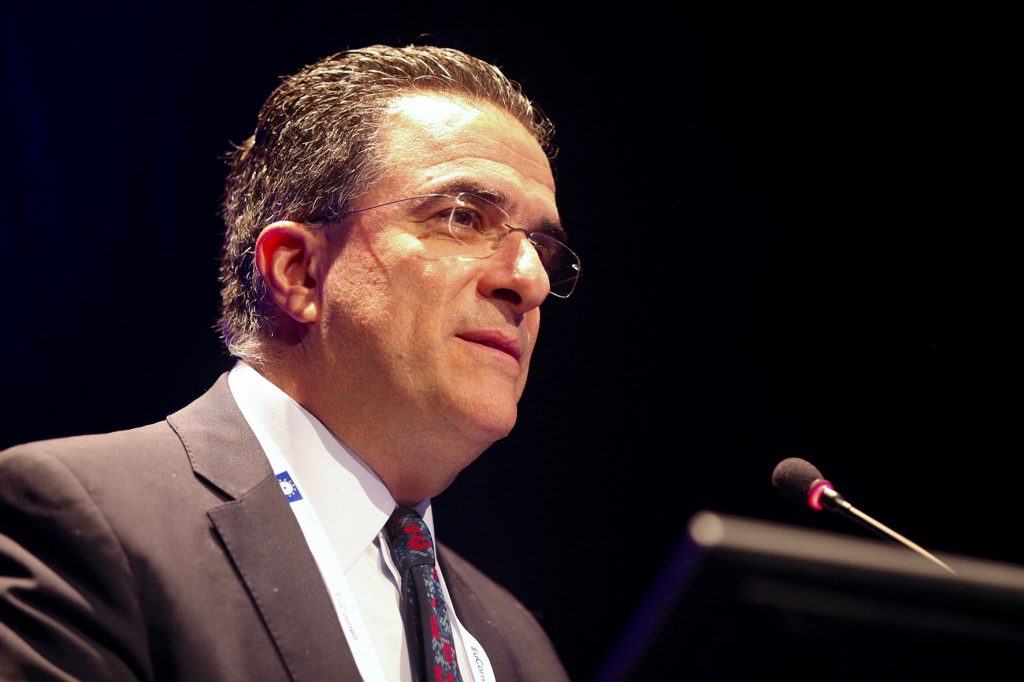Research is a moral imperative
Changing practice patterns changes the lives of many

Priscilla Lynch
Published: Saturday, September 14, 2019
 Sadeer Hannush[/caption]
THE importance of research in advancing new methods of practice, and thus improving outcomes for patients, cannot be overstated, delegates attending the EuCornea Congress Medal Lecture were told yesterday.
This year, the esteemed lecture was presented by Sadeer Hannush MD, USA, on the topic of “Clinical Corneal Research: Why It Is Important to Get Involved”.
The lecture drew on Dr Hannush’s three-decade post-training experience in the areas of cornea and external disease, maintaining a private practice while actively involved in significant academic medicine.
PRACTICE PATTERNS
Answering why one should become involved in research, Dr Hannush commented: “An average ophthalmologist may touch the lives of 40,000 people during the course of a career. If we change practice patterns, on the other hand, we can touch the lives of millions.”
During his lecture, Dr Hannush emphasised the importance of collaboration as being essential to robust and sound clinical research. Good-quality research should ask a simple, high-impact question and should aim to be practice-confirming or practice-changing, he said.
Dr Hannush acknowledged that research doesn’t come easy; “you have to learn the trade of it”, and outlined a number of practical tips for becoming involved in high-quality research. The first steps involve “not being content with the ‘what and how’, and having a drive to answer why”.
He also pointed out that not all important ophthalmology research was government funded: “Phacoemulsification revolutionised eye surgery and it was industry funded!”
Speaking about his own high-impact work over the years, Dr Hannush noted how research can confirm something that clinicians suspect from practice or it can throw up surprises.
For example, his own collaborative research studies on corneal transplants have shown that older cornea donor age (even over the age of 70 years) does not result in poorer quality outcomes, and neither does longer preservation time (eight-to-11 days).
Prior to these research studies it was believed that cornea donors should ideally be under the age of 25 or 30 years and corneal tissue should only ideally be transplanted if it was as fresh as possible and preserved for under a week. So, this knowledge is practice-changing.
Concluding his Medal Lecture to a huge round of applause, Dr Hannush said: “Treating patients changes the lives of the few. Changing practice patterns changes the lives of many. Collaborative clinical research is the only way to make this possible. It is our responsibility and a moral imperative!”
Sadeer Hannush[/caption]
THE importance of research in advancing new methods of practice, and thus improving outcomes for patients, cannot be overstated, delegates attending the EuCornea Congress Medal Lecture were told yesterday.
This year, the esteemed lecture was presented by Sadeer Hannush MD, USA, on the topic of “Clinical Corneal Research: Why It Is Important to Get Involved”.
The lecture drew on Dr Hannush’s three-decade post-training experience in the areas of cornea and external disease, maintaining a private practice while actively involved in significant academic medicine.
PRACTICE PATTERNS
Answering why one should become involved in research, Dr Hannush commented: “An average ophthalmologist may touch the lives of 40,000 people during the course of a career. If we change practice patterns, on the other hand, we can touch the lives of millions.”
During his lecture, Dr Hannush emphasised the importance of collaboration as being essential to robust and sound clinical research. Good-quality research should ask a simple, high-impact question and should aim to be practice-confirming or practice-changing, he said.
Dr Hannush acknowledged that research doesn’t come easy; “you have to learn the trade of it”, and outlined a number of practical tips for becoming involved in high-quality research. The first steps involve “not being content with the ‘what and how’, and having a drive to answer why”.
He also pointed out that not all important ophthalmology research was government funded: “Phacoemulsification revolutionised eye surgery and it was industry funded!”
Speaking about his own high-impact work over the years, Dr Hannush noted how research can confirm something that clinicians suspect from practice or it can throw up surprises.
For example, his own collaborative research studies on corneal transplants have shown that older cornea donor age (even over the age of 70 years) does not result in poorer quality outcomes, and neither does longer preservation time (eight-to-11 days).
Prior to these research studies it was believed that cornea donors should ideally be under the age of 25 or 30 years and corneal tissue should only ideally be transplanted if it was as fresh as possible and preserved for under a week. So, this knowledge is practice-changing.
Concluding his Medal Lecture to a huge round of applause, Dr Hannush said: “Treating patients changes the lives of the few. Changing practice patterns changes the lives of many. Collaborative clinical research is the only way to make this possible. It is our responsibility and a moral imperative!”